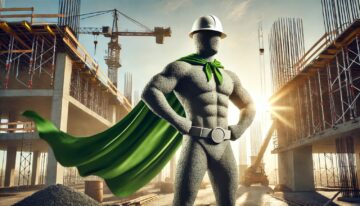When you walk on a sidewalk, drive over a bridge, or step into a high-rise building, you’re interacting with one of the most versatile, durable, and superhero-level strong materials on the planet—concrete. This unsung hero is holding up cities, spanning rivers, and creating the very floors beneath our feet. But have you ever wondered what makes concrete so incredible?
Explore 12 Futuristic Technology Trends Solving Concrete's Biggest Challenges.
Read more about how concrete innovations are transforming construction! Click here.
Let’s take a fun dive into the world of concrete. Spoiler: it’s not as boring as it sounds! We’ll break down what it’s made of, why it’s so awesome, and even introduce you to some sneaky “super ingredients” that give concrete extra powers. Ready? Let’s get mixing!
What Is Concrete? Meet the Dream Team!
At its core, concrete is a simple mix of ingredients that work together like a superhero team, each with its unique superpowers. When they join forces, they create a material that is tough enough to build skyscrapers, highways, and even dams. Here’s a breakdown of the all-star cast:
1. Cement – The Glue That Holds it All Together
Cement is like the team leader. It’s a fine, gray powder made from limestone and clay. When mixed with water, it undergoes a chemical reaction called hydration, which gives concrete its incredible strength. Cement’s job is to bind everything together and make the mix rock-solid (literally!). Think of cement as the glue holding all the other ingredients in place.
2. Water – The Magic Activator
Water is the unsung sidekick of the cement. Without it, nothing happens! When water meets cement, it forms a paste that hardens into concrete over time. Water helps start the hardening process (aka curing) and determines how strong and durable the final concrete will be. Too little water and your concrete is a crumbly mess. Too much water, and you get a soupy disaster. The balance is key—kind of like getting the perfect mix for your pancake batter!
3. Aggregates – The Bulking Agents
Now we bring in the muscle—aggregates. These are the rocks, sand, or gravel that give concrete its bulk and strength. Aggregates make up about 60% to 80% of the volume of concrete. Without them, you’d end up with a weak and expensive mix. It’s like adding oats to a smoothie: they bulk it up and make it stronger!
4. Chemical Admixtures – The Secret Weapons
Here’s where things get fun. Concrete’s superpowers come from chemical admixtures, the secret weapons that give it extra abilities depending on what you need. Admixtures are like special potions that can make concrete dry faster, stay flexible longer, or even resist water. These little helpers can make concrete more durable in cold climates, reduce cracks, or even make it easier to pour into complex molds.
Some common chemical admixtures include:
- Accelerators: Speed up the hardening process, like hitting fast-forward on your concrete.
- Retarders: Slow down the hardening process so you have more time to work with the mix.
- Plasticizers: Make the concrete more fluid without adding more water, perfect for when you need it to flow into every nook and cranny.
- Air-entraining agents: Add tiny bubbles to the mix, making the concrete more resistant to freeze-thaw cycles (perfect for places with cold winters!).
Now that we’ve met the crew, let’s talk about how they come together to make concrete the incredible material we know and love.
The Concrete-Making Process: Mix, Pour, and Cure!
Making concrete is like whipping up a batch of super-powered cake batter—only instead of sugar and flour, you’re using cement, water, and rocks. Here’s how the magic happens:
1. Mixing
First, the dry ingredients (cement and aggregates) are combined in a mixer. Then, water and any needed chemical admixtures are added to the mix. You stir it all together until it forms a thick, gray paste that’s ready to be shaped into anything you can imagine. It’s like baking a cake—only this one will support a bridge!
2. Pouring
Next, the concrete mix is poured into molds or forms, which give it its final shape. Whether you’re making the foundation of a building, a driveway, or a set of stairs, the form is the mold that shapes the concrete until it hardens. Pouring is like filling your cake pan!
3. Curing
After pouring, the concrete doesn’t just dry—it cures. The curing process is what makes concrete strong. As the water and cement react, the paste hardens, bonding everything together. For the best results, the concrete needs to be kept moist during curing to prevent cracks. It’s kind of like letting your cake cool down without cutting into it too early.
4. Finishing
Once the concrete is partially cured, it can be smoothed, textured, or polished. Whether you want a shiny floor, a bumpy driveway, or perfectly smooth walls, this step is where you get creative. It’s like putting icing on your cake!
Why Is Concrete So Cool? (Literally!)
Now that we’ve cracked the recipe, let’s talk about why concrete is such a superstar in the construction world. Here’s what makes concrete the material of choice for building… well, almost everything:
1. Strength
Concrete is like the Hulk of construction materials. It’s incredibly strong in compression, meaning it can handle tons of weight pushing down on it. That’s why it’s used in foundations, columns, and bridges. It doesn’t crack under pressure!
2. Durability
Concrete can survive just about anything Mother Nature throws at it—rain, wind, heat, or freezing temperatures. If you want something to last for decades (or even centuries), concrete is your go-to material. It’s the Energizer Bunny of construction!
3. Versatility
Concrete can take on virtually any shape you want. Whether you need a smooth floor, a curvy staircase, or a bridge with wild angles, concrete is flexible enough to handle it. It’s the shapeshifter of building materials!
4. Sustainability
While making cement (a key ingredient) does produce some CO2 emissions, concrete can still be eco-friendly. By using recycled aggregates or mixing in materials like fly ash (a byproduct from coal plants), we can reduce its environmental impact. Plus, concrete structures last a long time, meaning less waste and fewer rebuilds. Concrete is like the Captain Planet of construction!
Types of Concrete: The Super Variants
Just like superheroes, concrete comes in different forms, each with its unique abilities. Let’s check out some of the coolest types of concrete:
1. Reinforced Concrete
By adding steel bars or mesh inside the concrete, we give it extra superpowers! Reinforced concrete can handle not only compression but also tensile forces—those that try to pull it apart. It’s the Superman of the concrete world, used in buildings, bridges, and skyscrapers.
2. Precast Concrete
This type of concrete is like building with giant Lego blocks! Precast concrete is made in a factory, shaped into specific pieces, and then transported to the construction site. It’s used in things like walls, floors, and bridges. It saves time on-site and ensures consistent quality.
3. Lightweight Concrete
Imagine regular concrete but on a diet! Lightweight concrete is made with special aggregates like expanded clay, which reduces its weight without compromising its strength. It’s perfect for projects where you need strength but can’t afford the bulk, like high-rise buildings.
4. Self-Consolidating Concrete (SCC)
This type of concrete flows like water—no need for mechanical vibration! SCC is great for filling complex forms or creating smooth finishes. It’s the smooth operator of the concrete family!

Read more about concrete and the time it takes to set, click here.
Concrete in Everyday Life: Superheroes Among Us
You don’t have to be a construction worker to experience the wonders of concrete. It’s all around us, from the roads we drive on to the sidewalks we walk. Here are just a few places where concrete plays its role as an everyday superhero:
- Buildings: Concrete is in the foundations, walls, and floors of nearly every building.
- Bridges: Those incredible spans across rivers? Concrete’s got it covered.
- Roads: Many highways are made from concrete for durability and strength under heavy traffic.
- Sidewalks: Concrete keeps our streets walkable and smooth.
Concrete Is the Real MVP
Concrete might not wear a cape, but it’s definitely the MVP of the construction world. Its strength, durability, and versatility make it an essential material for building the cities, roads, and infrastructure that keep our world running. Plus, with innovations like smart concrete and 3D-printed concrete, the future of this super material looks brighter than ever. So, the next time you walk on a sidewalk, drive on a road, or admire a skyscraper, give a little nod to concrete. It’s the superhero you never knew you needed!










